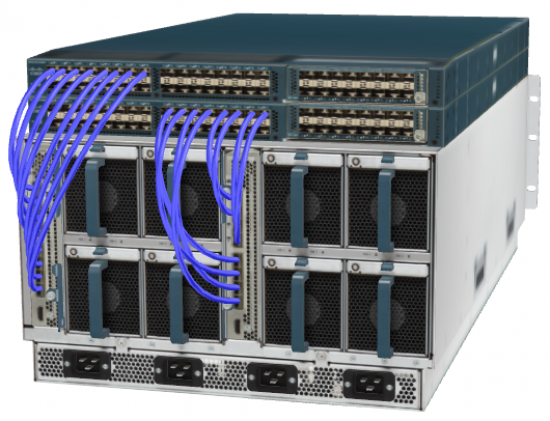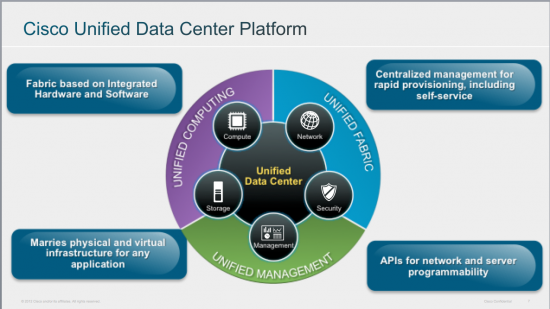There are a number of trends that are impacting data centers today, many of which will have a profound impact on how businesses consume data center resources. These can provide a variety of challenges. Perhaps most obvious, is the fact that people and businesses are more connected than ever with the proliferation of mobile devices and tablets. These new devices are driving more applications, more users, and an insatiable appetite for network bandwidth. This blog will discuss a few of these trends and how Cisco is shaping its data center strategy to enable customers to meet these rapidly changing demands.

Another major data center trend that is driving change in the data center is the continued adoption of virtualization technologies. What’s interesting is that although server spending has remained relatively flat for over a decade, there is still a great deal of “head room” for companies to further adopt virtualization.

In fact, IDC studies show that many applications are yet to be virtualized as the chart to the right indicates. However, virtualization is driving complexity elsewhere including the network, software and storage. So what has created a more agile server, has not necessarily created a more agile system.
The next major trend is that of Cloud Computing, with more business leveraging private, public or potentially even hybrid cloud models. Some actually forecast that there could eventually be a small number of mega data centers and companies will all leverage capacity exclusively from these since they can offer extreme efficiencies. The truth is, there are two ends of the spectrum, some customers will prefer to host their own infrastructure and others may choose to use Cloud providers exclusively. We are finding today that many customers are somewhere in the middle and choose their model based on the application needs.
Finally, one of the hottest topics in the industry lately is around big data and the actual dollar value that businesses are deriving from making sense from tons of unstructured data. Virtually every field is turning to gathering big data, with mobile sensor networks, cameras on the ground and in the air, and archives storing information published on the web. The challenge is ON to invent new tools and techniques that can mine vast stores of data to inform decision making in ways that were previously unimagined. The fact that we can derive more knowledge by joining related information together and recognizing correlations can inform and enrich numerous aspects of every day life. For example, either in real time for traffic or financial conditions, short term evolution such as medical or weather, or in prediction situations such as business, crime or disease trending.
Whatever the requirement, data center providers need to support all of the models above and work to solve these major challenges to remove complexity, increase efficiencies, and streamline the businesses ability to react more quickly to new opportunities.
So how do we handle the massive increases that are coming in terms of network bandwidth, compute, storage and software?

That said, businesses are under pressure from a number of angles including business as well as technology challenges. From a business perspective, one of the most significant challenges we are seeing today is around business agility, or the ability of business to react more quickly to changing business opportunities. How can businesses turn on resources and launch applications more quickly. In many cases, those that can react more quickly gain significant competitive advantage. Those that can’t, are missing opportunities for revenue growth. In addition, business must deal with 24×7, always on, requirements for resources, as well as security issues, especially when compliance is involved, and cost pressures, which are always an issue as businesses cope with trying to continuously do more with less.
From a Technology standpoint, one of the top challenges in recent years has become the ability for IT Managers to appropriately manage capacity. As new servers are provisioned and more virtual machines are defined, there becomes less predictability in terms of bandwidth requirements. Over provisioning is usually not an option either since that can get very expensive. In addition, IT Managers face challenges around availability and business continuance, requiring customers to have a backup plan in case of a natural disaster. And finally, IT managers must navigate a very dynamic application environment where almost anyone can develop applications these days.
Cisco is developing innovations for the data center that are addressing the challenges mentioned above by offering businesses the ability to support all of these desired resource consumption models. Our strategy for the data center is called, Cisco Unified Data Center. It allows businesses to leverage IT as a Service. This starts by offering a more dynamic and programmable approach to data center resources.
What is Cisco Unified Data Center?
Cisco’s Unified Data Center strategy combines data center innovations in three primary areas, Unified Fabric, Unified Computing and Unified Management. It’s these three areas of innovation that set Cisco apart.
First, Cisco Unified Fabric is a data center network that supports both traditional LAN traffic and all types of storage traffic, tying everything together with a single OS (Cisco NX-OS) and if desired, with a single cable called Fibre Channel over Ethernet (FCOE). In addition, this single wire management capability of Unified Fabric also encapsulates the management traffic as well, allowing all three types of network traffic to converge onto a single, 10GE cable.
Cisco Unified Fabric creates high-performance, low-latency, and highly available network. It delivers reliable, scalable, agile and cost-effective network services to servers, storage, and applications while improving user experience. It also facilitates better support of virtualization and cloud services with drastically improved staff efficiency and resource utilization. I can’t emphasize how much this technology is changing the economics of the data center and I urge you to take a much closer look. In fact, Unified Fabric is one major technology innovation that provides Cisco Unified Computing with such an amazing industry advantage over traditional computing architectures.
Cisco Unified Computing System (UCS) leverages the innovations from both Unified Fabric and Unified Management to create a more holistic data center solution. Cisco UCS combines compute, network, virtualization and access to storage into a single system. This has actually created a new category of data center products that Gartner refers to as “Fabric-Based Computing”.
A couple major differences come to mind when comparing UCS to traditional server architectures. First, Cisco has removed the management controllers from the blade servers and located them centrally in the Fabric Interconnects. Fabric Interconnects are essentially, Nexus 5000 access layer switches that have been modified to manage the servers directly and are now called, UCS 6200 Series Fabric Interconnects. By managing the compute centrally from the network via UCS Manager, we’ve managed to remove much of the complexity associated with managing traditional servers. I’ll provide more on that in a moment when I discuss Unified Management in more detail.

The next major difference with Cisco UCS is that Cisco has abstracted all of the identity and configuration information from the compute and network components and put them into something we call a “Service Profile”, which is essentially a software definition of the hardware resources. This provides some incredible benefits to our customers. Since service profiles are software based, they provide customers with a dynamic, programmable infrastructure, that’s easy to duplicate, easy to provision, and easy to automate. In fact, whether you have 1 server or up to 160 servers in a single domain, there is no added complexity to manage these systems.
There are many other innovations in UCS, such as the ability of a VM to move easily from server-to-server, rack-to-rack or even data center-to-data center, while maintaining the associated policy. This is the topic of many whitepapers so I won’t cover it all here but the list of benefits within UCS is long. In fact, it’s long enough that Cisco UCS now has over 23,000 customers and has recently become the #2 x86 blade server worldwide in market share, currently with 19.3% and is closing in on HP every quarter. Again, I suggest it’s worth a much closer look!
Here is a market share slide that Matt Eastwood from IDC posted on Twitter recently:
Finally, the third primary area of data center innovation that makes up Cisco’s Unified Data Center strategy is that of Cisco Unified Management. Cisco Unified Management encompasses much more than UCS Manager, it also includes UCS Central, UCS Director (formerly Cloupia), Cisco Intelligent Automation for Cloud, Nexus OS (NX-OS) and Data Center Network Manager (DCNM).
UCS Central is essentially a manager of managers. Consider a single domain of UCS to be a pair of Fabric Interconnects where an instance of UCS Manager resides and manages up to 160 servers and all of their I/O connectivity. UCS Central now allows administrators to manage multiple domains of UCS and scale their aggregate environment to the range of 10,000 servers within a data center or across geographically dispersed data centers.
On the other hand, Cisco Cloupia, delivers unified management across industry-leading integrated infrastructure solutions based on Cisco Unified Computing System (UCS) and Cisco Nexus technologies. Examples include FlexPod, VSPEX, HDS and SmartStack integrated solutions. This unified management supports cohesive, flexible data centers that increase IT and business agility, while reducing operational processes and expenses.
Finally, Cisco Intelligent Automation for Cloud (CIAC) is a cloud management software solution that delivers a critical foundation layer for deploying and managing cloud-based computing in a holistic and unified way and is specifically designed for Cisco UCS. The solution provides essential automated management and orchestration that allows organizations to control and manage cloud-based services transparently throughout their life cycles.
By implementing a fabric-based data center that abstracts the identity and configuration information out of the hardware and automating much of the manual provisioning activities, Cisco has been able to dramatically reduce time to provision and deploy resources from 8 weeks down to about 15 minutes. The benefits customers are quoting on average include 30% lower infrastructure costs, 50% faster disaster recovery, 90% less deployment times, existing staff can manage double the capacity, 60% power and cooling savings, and 30% faster application performance. As mentioned, these are the average of the results we’ve seen from our customer testimonials but, of course, results may vary somewhat.
In conclusion, Cisco’s Unified Data Center strategy is backed by tremendous innovation in each of the three areas I’ve covered above. I’ve really just scratched the surface to offer you some insight into Cisco’s offerings, leaving you many more goodies yet to be discovered. Cisco is changing the economics of the data center with a new innovative, fabric-based computing portfolio that leverages Cisco’s core strength in the network to deliver business agility, financial efficiency and IT simplification. This enables your business to maximize your DC investment and react more quickly to changing business demands.
By the way, Cisco will be showcasing our Unified Data Center portfolio at Red Hat Summit in Boston from June 11th to June 14th at the Partner Pavillion as well as in Orlando, Florida at Cisco Live, starting June 23rd. Stop by and say hello and let me know if you have any comments or questions, or via twitter at @CicconeScott.



Awesome wrap-up very helpful in “netting out” some of the changes and directions we need to be aare of and to help our customers with.
Hi Ian,
Thanks for the feedback! Glad you found this helpful!
Best Regards,
Scott